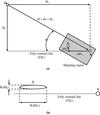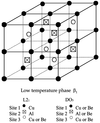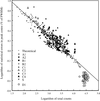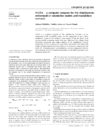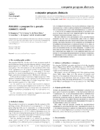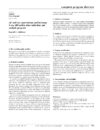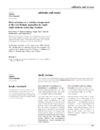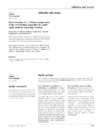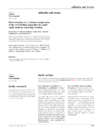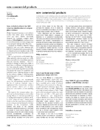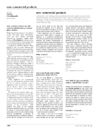issue contents
December 2001 issue

Cover illustration: Diffuse scattering around a 200 Bragg peak from a Cu-Ti single crystal (the intensities are in ln scale, the plane is (001), with the [100] direction horizontal, and the Bragg peak is masked by the blue beam stop). Courtesy of O. Lyon, C. Servant & J. P. Simon [J. Appl. Cryst. (2000), 33, 928-937].
research papers
A new method for analysing X-ray peak broadening caused by compositional fluctuation is proposed. The method is useful for simple identification of X-ray peak broadening caused by compositional fluctuation for samples with various types of epitaxial layers.
A modified least-squares analysis is presented that allows reliable structural parameters to be extracted from a powder diffraction pattern even in the presence of a substantial unmodelled impurity contribution. The algorithm is developed within the context of Bayesian probability theory.
Profile fitting procedures associated with integral breadth studies and Fourier analysis are applied to the study of the complex Bi-containing layered perovskite SrBi2Nb2O9. Strong anisotropic line broadening is observed.
A new full-pattern decomposition procedure for powder data is described, aiming at improving the phasing process.
Download citation


Download citation


The crystal structures of the isostructural [Ni(C12H6O4)(H2O)4] and [Co(C12H6O4)(H2O)4] have been determined using Monte Carlo simulated annealing techniques and laboratory X-ray powder diffraction data. The water-molecule hydrogen atoms were located by quantum chemical geometry optimization; molecular mechanics energy minimizations suggest that coordination and hydrogen-bonding interactions are most important in determining the crystal packing.
The application of X-ray mapping in reciprocal space to the measurement of the subtle strain modifications in epitaxically grown structures as well as in implanted structures with unknown lattice mismatches is analysed. Special attention is paid to the reasons for the enhanced precision of this technique as compared with the diffraction profile measurements.
X-ray diffraction experiments were carried out to prove that X-ray methods can be used to assess strain-induced fatigue in CuAlBe shape-memory alloys.
The practical aspects of a recently deduced formalism for the direct solution of the powder diffraction pattern of a layer crystal are addressed. The solution when combined with a deconvolution procedure based on a series development can yield the correlation function between laterally displaced layers.
A simple expression is presented for estimating the precision of diffraction peak location that can be achieved for a Gaussian diffraction peak with a flat background, in terms of the standard deviation, integrated intensity and peak height to background ratio. The efficacy of the expression is confirmed by simulation and by application to neutron diffraction peak profiles obtained at many facilities worldwide as part of a residual-strain determination round robin study.
A method is presented for fast and non-destructive characterization of individual grains inside bulk materials with respect to position, volume and orientation.
Based on the tracking concept, a fast and non-destructive method for mapping the grain boundaries of a polycrystal in three dimensions is demonstrated. Furthermore, methods for characterizing the stress state of the individual embedded grains are presented.
Rietveld refinements on energy dispersive X-ray data are reported.
This paper discusses research devoted to the study of the intensity change of diffracted and transmitted X-ray beams under the action of a temperature gradient or acoustic oscillations, as well as the techniques for `controllable complete reflection' of transmitted X-radiation in the direction of the diffracted beam.
teaching and education
Free 

An interactive teaching tutorial on diffraction, using computer simulations, is presented. Interaction with the simulation program is performed via an interface that can be accessed with any Internet browser.
short communications
The scattering intensity of a straight chain of N identical spheres and its radius of gyration are reported.
computer programs
Documentation of the Situs package and demonstration of its use in visualization and mutual registration of atomic structures and low-resolution bead models from X-ray solution scattering are presented.
The computer program NADA refines simultaneously the orientation matrix and the components of up to three modulation vectors by the least-squares method.
The MCGR program of Pusztai & McGreevy has been modified to account for the experimental resolution of time-of-flight neutron diffractometers.
computer program abstracts
The program PSEUDO performs a pseudosymmetry search among the supergroups of the space group of a given structure.
A program system to analyse, correct and merge single-crystal synchrotron or in-house X-ray diffraction data is described.
A Fortran program, SM, for unfolding two-dimensional data by Siska's method is described.
addenda and errata
Free 

books received
Free 

Free 

new commercial products
Free 

Free 

Free 



 journal menu
journal menu
















